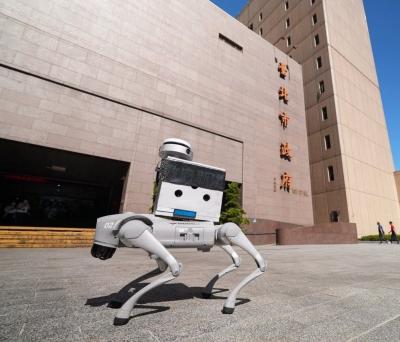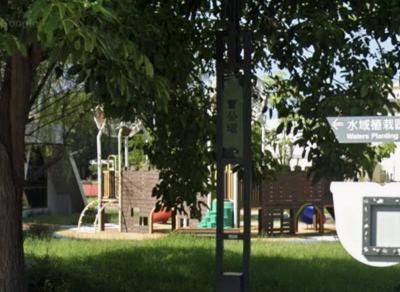Railway industry experts and Keelung residents criticized President Tsai Ing-wen’s (蔡英文) pledge to build a light railway between Taipei and Keelung by 2021, saying that the project is unnecessary and does not address residents’ real needs.
Tsai on Friday announced that the government has earmarked NT$8.1 billion (US$264.48 million) to build a tram-train connecting Keelung Port — which the government aims to turn into a home port for international cruise ships — to Taipei’s Nangang District (南港).
The project would be Taiwan’s first to use tram-trains, which would operate on roads and Taiwan Railways Administration (TRA) tracks, Tsai said
“Keelung residents have been expecting a mass rapid transit [MRT] system for decades and none of the previous administrations could provide it. I want to tell everyone in Keelung that we will definitely deliver it. The Democratic Progressive Party administration has the will and determination to ensure that Keelung gets an MRT,” Tsai said.
Europe’s tram-train systems are often built in remote areas that service a relatively small volume of passengers, Society of Railway and National Planning secretary-general Chen Yen-liang (陳彥良) said.
The TRA’s railway service between Keelung and Nangang is already under pressure because of the frequency of trains, and the project would entail its limited railway line capacity being shared with a light railway system, he said.
“The light railway would only take passengers to Taipei’s MRT Nangang Exhibition Center Station and people would have to change trains at Keelung’s Badu (八堵) train station if they want to go to Taipei Railway Station. It would not even be connected to the high-speed rail system,” Chen said, adding that the proposal is nothing more than a bid to fulfill a campaign promise.
“Rather than building a light railway whose trains run only slightly faster than TRA trains, the government should use the earmarked funds to buy new commuter trains,” he said.
A former Keelung resident surnamed Chang (張), who now lives in New Taipei City’s Sanchung District (三重) and commutes daily between her home and Keelung, said the proposed light railway is unnecessary.
“Keelung does not have a big department store, because people in Keelung go to Taipei to do their shopping,” she said. “Nearly all the buses to Taipei — to the city’s Xinyi District (信義), Chang Kung Memorial Hospital, Hsin Tian Temple, or National Taiwan University — depart from Keelung Railway Station. The buses leave about every 15 minutes during peak hours, making them even more convenient than the inner-city bus system sometimes,” she said.
Keelung has more mountain fortresses built during the Qing Dynasty or the Japanese colonial era than anywhere else in the nation, Chang said.
The government should use the money it wants to spend on the light railway to improve access to these tourist destinations, she said.
A netizen named Liu Po-shen said that not many roads in Keelung have extra space for a light railway line to be built.
“National Sun Yat-sen Freeway [Freeway No. 1] has only two lanes between Keelung and [New Taipei City’s] Sijhih district (汐止), and congestion often occurs at the Wudu (五堵) Interchange because of traffic from Provincial Highway 62. They should extend the overpass between Wugu (五股) and Yangmei (楊梅) on the Sun Yat-Sen Freeway all the way to Keelung,” Liu said.
Keelung residents need railway lines from Keelung Railway Station to be extended to the city’s outlying districts, such as the one from Taipei Railway Station that goes to New Taipei City’s Sindian (新店), netizen Tsai Yi-lin said, adding that residents in most areas of Keelung can get to Taipei faster by bus.

The inspection equipment and data transmission system for new robotic dogs that Taipei is planning to use for sidewalk patrols were developed by a Taiwanese company, the city’s New Construction Office said today, dismissing concerns that the China-made robots could pose a security risk. The city is bringing in smart robotic dogs to help with sidewalk inspections, Taipei Deputy Mayor Lee Ssu-chuan (李四川) said on Facebook. Equipped with a panoramic surveillance system, the robots would be able to automatically flag problems and easily navigate narrow sidewalks, making inspections faster and more accurate, Lee said. By collecting more accurate data, they would help Taipei

TAKING STOCK: The USMC is rebuilding a once-abandoned airfield in Palau to support large-scale ground operations as China’s missile range grows, Naval News reported The US Marine Corps (USMC) is considering new sites for stockpiling equipment in the West Pacific to harden military supply chains and enhance mobility across the Indo-Pacific region, US-based Naval News reported on Saturday. The proposed sites in Palau — one of Taiwan’s diplomatic allies — and Australia would enable a “rapid standup of stored equipment within a year” of the program’s approval, the report said, citing documents published by the USMC last month. In Palau, the service is rebuilding a formerly abandoned World War II-era airfield and establishing ancillary structures to support large-scale ground operations “as China’s missile range and magazine

A 72-year-old man in Kaohsiung was sentenced to 40 days in jail after he was found having sex with a 67-year-old woman under a slide in a public park on Sunday afternoon. At 3pm on Sunday, a mother surnamed Liang (梁) was with her child at a neighborhood park when they found the man, surnamed Tsai (蔡), and woman, surnamed Huang (黃), underneath the slide. Liang took her child away from the scene, took photographs of the two and called the police, who arrived and arrested the couple. During questioning, Tsai told police that he had met Huang that day and offered to

A British man was arrested for attempting to smuggle 14.37kg of marijuana into Taiwan through Taiwan Taoyuan International Airport, Taipei Customs said late yesterday. The man, who arrived from Bangkok at 9pm on Friday, was asked by customs officers to open his luggage during a random inspection, Taipei Customs said in a news release. The passenger, whose identity was not disclosed, refused to open his suitcase and tried to flee the restricted area. He was eventually subdued by three customs officials and an Aviation Police Bureau officer. A later search of his checked luggage uncovered 14.37kg of marijuana buds. The case was handed over